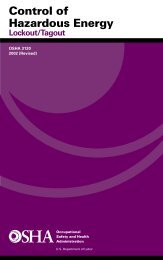Toxic Chemical Release Inventory Reporting Forms and Instructions
Toxic Chemical Release Inventory Reporting Forms and Instructions
Toxic Chemical Release Inventory Reporting Forms and Instructions
You also want an ePaper? Increase the reach of your titles
YUMPU automatically turns print PDFs into web optimized ePapers that Google loves.
<strong>Instructions</strong> for Completing Part II of EPA Form R<br />
year is 2002. Information available at the facility that may be<br />
used to estimate the prior year’s quantities include the prior<br />
year’s Form R submission, supporting documentation, <strong>and</strong><br />
recycling, energy recovery, treatment, or disposal operating logs<br />
or invoices. When reporting prior year estimates facilities are<br />
not required to use quantities reported on the previous year’s<br />
form if better information is available.<br />
Column B: Current <strong>Reporting</strong> Year<br />
Quantities for Sections 8.1 through 8.7 must be reported for the<br />
current reporting year in column B.<br />
Columns C <strong>and</strong> D: Following Year <strong>and</strong><br />
Second Following Year<br />
Quantities for Sections 8.1 through 8.7 must be estimated for<br />
2004 <strong>and</strong> 2005. EPA expects reasonable future quantity<br />
estimates using a logical basis. Information available at the<br />
facility to estimate quantities of the chemical expected during<br />
these years include planned source reduction activities, market<br />
projections, expected contracts, anticipated new product lines,<br />
company growth projections, <strong>and</strong> production capacity figures.<br />
Respondents should take into account protections available for<br />
trade secrets as provided in EPCRA section 322 (42 USC<br />
11042) for the chemical identity.<br />
Relationship to Other Laws<br />
The reporting categories for quantities recycled, used for energy<br />
recovery, treated, <strong>and</strong> disposed apply to completing Section 8<br />
of Form R as well as to the rest of Form R. These categories are<br />
to be used only for TRI reporting. They are not intended for use<br />
in determining, under the Resource Conservation <strong>and</strong> Recovery<br />
Act (RCRA) Subtitle C regulations, whether a secondary<br />
material is a waste when recycled. These definitions also do not<br />
apply to the information that may be submitted in the Biennial<br />
Report required under RCRA. In addition, these definitions do<br />
not imply any future redefinition of RCRA terms <strong>and</strong> do not<br />
affect EPA*s RCRA authority or authority under any other<br />
statute administered by EPA.<br />
Differences in terminology <strong>and</strong> reporting requirements for<br />
EPCRA section 313 chemicals reported on Form R <strong>and</strong> for<br />
hazardous wastes regulated under RCRA occur because EPCRA<br />
<strong>and</strong> the PPA focus on specific chemicals, while the RCRA<br />
regulations <strong>and</strong> the Biennial Report focus on waste streams that<br />
may include more than one chemical. For example, a RCRA<br />
hazardous waste containing an EPCRA section 313 chemical is<br />
recycled to recover certain constituents of that waste, but not the<br />
toxic chemical reported under EPCRA section 313. The<br />
EPCRA section 313 chemical simply passes through the<br />
recycling process <strong>and</strong> remains in the residual from the recycling<br />
process, which is disposed. While the waste may be considered<br />
recycled under RCRA, the EPCRA section 313 chemical<br />
constituent would be considered to be disposed for TRI<br />
purposes.<br />
Quantities Reportable in Sections 8.1–8.7<br />
Section 8 of Form R uses data collected to complete Part II,<br />
Sections 5 through 7. For this reason, Section 8 should be<br />
completed last. Sections 8.1, 8.3, 8.5, 8.7, <strong>and</strong> 8.8 use data<br />
collected to complete Sections 5 <strong>and</strong> 6 of Form R. The<br />
relationship between Section s 5, 6, <strong>and</strong> 8.8 to Sections 8.1, 8.3,<br />
8.5, <strong>and</strong> 8.7 are provided below in equation form.<br />
Section 8.1. Beginning in the 2003 reporting year Section 8.1<br />
has been divided into four Subsections (8.1a, 8.1b, 8.1c <strong>and</strong><br />
8.1d). Please refer to the following equations that show the<br />
relationship between Sections 5, 6 <strong>and</strong> 8.1a through 8.1d.<br />
EPCRA section 329(8) defines release as “any spilling, leaking,<br />
pumping, pouring, emitting, emptying, discharging, injecting,<br />
escaping, leaching, dumping, or disposing [on-site or off-site]<br />
into the environment (including the ab<strong>and</strong>onment of barrels,<br />
containers, <strong>and</strong> other closed receptacles).” In Section 8.1<br />
facilities report disposal <strong>and</strong> other releases. This includes onsite<br />
disposal <strong>and</strong> other releases in Section 5 <strong>and</strong> off-site disposal<br />
<strong>and</strong> other releases in Section 6 (releases plus transfers to<br />
disposal <strong>and</strong> transfers to POTWs of metals <strong>and</strong> metal<br />
compounds), but excludes quantities reported in Section 5 <strong>and</strong><br />
6 due to remedial actions, catastrophic events, or nonproduction<br />
related events (see the discussion on Section 8.8.)<br />
Example 19: <strong>Reporting</strong> Future Estimates<br />
A pharmaceutical manufacturing facility uses an EPCRA<br />
section 313 chemical in the manufacture of a prescription<br />
drug. During the reporting year (2003), the company<br />
received approval from the Food <strong>and</strong> Drug Administration<br />
to begin marketing their product as an over-the-counter<br />
drug beginning in 2004. This approval is publicly known<br />
<strong>and</strong> does not constitute confidential business information.<br />
As a result of this exp<strong>and</strong>ed market, the company estimates<br />
that sales <strong>and</strong> subsequent production of this drug will<br />
increase their use of the reported EPCRA section 313<br />
chemical by 30% per year for the two years following the<br />
reporting year. The facility treats the EPCRA section 313<br />
chemical on-site <strong>and</strong> the quantity treated is directly<br />
proportional to production activity. The facility thus<br />
estimates the total quantity of the reported EPCRA section<br />
313 chemical treated for the following year (2004) by<br />
adding 30% to the amount in column B (the amount for the<br />
current reporting year). The second following year (2004)<br />
figure can be calculated by adding an additional 30% to the<br />
amount reported in column C (the amount for the following<br />
year (2004) projection).<br />
<strong>Toxic</strong>s <strong>Release</strong> <strong>Inventory</strong> <strong>Reporting</strong> <strong>Forms</strong> <strong>and</strong> <strong>Instructions</strong> 61
















